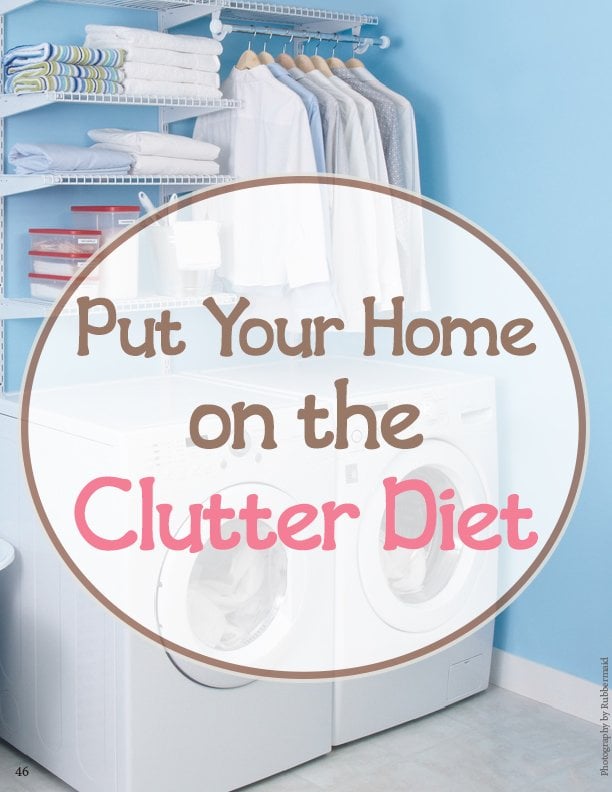How to Put Your Home on a Clutter Diet
Is your “stuff” starting to create physical and mental clutter? When you start to clean, do you find yourself shifting stuff from room to room? If so, here are simple and actionable tips to put your home on a clutter diet.

The Benefits of Removing Clutter from Your Home
If you’ve never thought about the connection between excess stuff and excess weight, this will be extremely interesting to you.
Clutter parallels weight gain.
It slowly adds up until you feel uncomfortable. Nothing fits. You’re slowed down by it. And pretty soon, you can barely fit in your house anymore and you feel ashamed of the way it looks.
Exercising alone is like shuffling things around. But do the math, if you have more stuff than you have space for, it is clutter!
You need to purge before you can get organized!
The definition of purge is: to rid of whatever is undesirable; cleanse, purify.
You know how some diets begin with a detox?
The rationale behind decluttering is the same.
Purging has some similarities with dieting. Both can make us uncomfortable, so let’s talk it through to help you to see the problem areas that are causing the weight gain/clutter, how to purge/diet, and how to burn the fat/clutter.
Why You Might Need to Go On a Clutter Diet
“The less you need to insure, protect, dust, reorganize, and move… the closer you’ll be to hearing inspiration’s call.” This quote from Dr. Wayne Dyer certainly offers a freedom we all crave. It also presents the question of whether you own your stuff, or your stuff owns you.
A cluttered home and chaotic schedule can do more than just make you feel tired. It can make you feel hopeless. It can cost money to store excess items you don’t use or replace items you know you own but can’t find. Worst of all, clutter can make you sick. Dust can lead to allergies, asthma and sinus problems.
Oddly enough, even though the clutter can make you feel exhausted, it can also keep you up at night. Not being able to find what you need and being overwhelmed by the clutter can lead to anxiety, depression and headaches. Piles of clutter blocking stairs or stacked high on shelves can cause falls and other injuries.
How to Put Your Home on a Clutter Diet
If you’re convinced you need to get your clutter under control, here’s how to tackle it. Be sure to give yourself plenty of time and plenty of grace. The stuff didn’t pile up overnight, and it’ll take a bit of time to pare it down.
Set a specific goal
Make a goal for yourself of what you want to organize. Create a vision board or Pinterest board of rooms you absolutely love and wish were yours. They will inspire and motivate you to reach your goal.
Write down on your calendar a date to aim for. Even make a schedule blocking off specific times or days just for purging and organizing each week. Make a mental picture and some plans of what you want your space to look like. Think of the fun stuff like the decorating and finishing touches. Now see yourself sitting there enjoying it.
Find the source of your clutter
Where does most of your clutter originate? Here are some of the common sources of clutter:
Bills, mail, paperwork
Children’s artwork and school papers
Coats, hats, gloves
Lists and reminder notes
Tools and items you leave out after projects
Laundry piles
Phone chargers and old electronic devices
Knickknacks and other decorative items
Purge and let go
Just as you would purge sugar, junk foods, and the things that are causing weight-gain from your diet, eliminate the clutter one step at a time. Remove the excess so it can no longer suffocate you from being who you really are!
If you have kids, their stuff can sometimes account for a lot of clutter in the home. Having access to fewer toys stimulates your child’s imagination and resourcefulness. But if you aren’t ready to purge (maybe you’re planning to have another child or don’t want to get rid of special items), start a toy rotation system to keep your everyday space open and clean.
Recycle or throw away broken items.
Donate items or clothing you haven’t used or worn in the last year.
Create a home for the essentials so they always have a place to be returned.
Unsubscribe from mailing lists.
Add any important information you find on miscellaneous lists to your home binder (download our free printable planner) or the notes section of your phone.
Scan old photos and important paperwork.
Be prepared for those cravings
Purging your home of clutter can be just as uncomfortable as taking sugar out of your diet… especially at the beginning. So be ready for your weakness with some pro-active planning. Some suggestions to help:
- Enlist the help of a friend to keep you on track with purging, getting organized, and practicing conscious spending in the future.
- Make yourself accountable, tell your favorite charity you will be dropping off a bag on Friday.
- Reward yourself. Treat yourself to an experience gift or something that makes you smile. You can keep this in mind as you are purging to keep you motivated. But, one word of caution, the reward shouldn’t add to the clutter.
Be reasonable
You want this to be your way of life, not a temporary fad that is impossible to stick to. You are on this road for life, so don’t expect too-much too-fast. Reduce clutter one room at a time, one drawer at a time. You don’t have to be a minimalist, just be balanced. It doesn’t all have to be perfect on the first go-round. Each circuit you do will get easier and more organized.
Exercise and build muscle
Establish some systems and habits to keep clutter/that weight off:
■ Use the one-in-one-out rule. When you buy something new, be prepared to get rid of one thing to make room for the new item.
■ Make the best use of your time/steps. For example, when opening the mail – either do it, file it, trash it, recycle it, but don’t leave it!
■ Blitz daily clutter. For example, before you go to bed, blitz through to pick up any garbage or clothes, put away magazines, clear counters, etc. A routine of just fifteen minutes a day will keep your clutter at bay!
Losing weight is hard only when you don’t see results. So it is with purging clutter, you will love how good your space looks, how much time you gain not searching for things that you will be inspired to keep going.
Great Reads on Organizing & Minimalism
Organize for a Fresh Start by Susan Fay West
The Life-Changing Magic of Tidying Up: The Japanese Art of Decluttering & Organizing by Marie Kondo
The Power of Less: The Fine Art of Limiting Yourself to the Essential by Leo Babauta
Organizing from the Inside Out by Julie Morgenstern
It’s All Too Much: An Easy Plan for Living a Richer Life with Less Stuff by Peter Walsh

